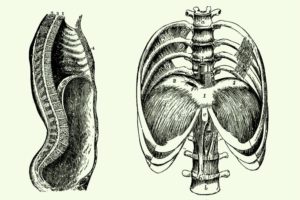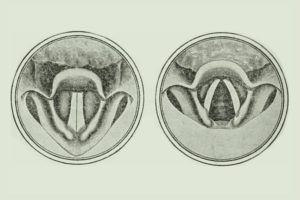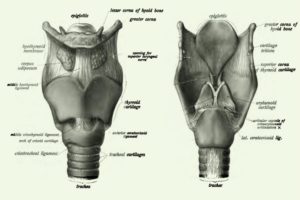Most people do not really take the time to consider the interesting work that goes on in the body when they sing. They seem to assume that the voice “appears” like magic when they want it.
Almost everyone has probably heard phrases like “singing with the diaphragm (or belly)” and “supporting the breath (or voice),” used frequently by many singing teachers. However, if a student does not understand basic human anatomy related to breathing and sound, these common expressions may become mysterious. It is not necessary to memorize all the complex parts and functions of vocal anatomy, but it is useful to gain a general and practical understanding of it. Understanding the terminology (e.g. diaphragm, support, intercostal muscles, resonance, hard palate, placement, etc.) is very important when it comes to understanding the anatomy of the human voice. The vocal technique is as much a science that singing is an art form. While in the beginning, there should be a focus on breathing, placement and muscle control, these techniques will become easier, more natural and even automatic over time, making the singing much more enjoyable.
Great books we recommend, Click on the image to know more! 🙂
The physics of breathing
Needless to say, an effective breathing technique is essential to good singing. Part of the process of studying the voice is to develop a keen awareness of the actions involved in breathing and to explore them in depth. A teacher is essential to help a student take control and, therefore, to trust his own breathing, and to guide him to a better understanding of the potential of his breath as an interpreter.
The mechanism of respiration can be summarized in this way:
Receiving various signals from the nervous system, the diaphragmatic muscles contract and the diaphragm moves downwards. As the diaphragm depresses, it creates a vacuum in the lungs and the air rushes to fill that void. During exhalation, the diaphragm relaxes and increases and the lungs volume decreases, creating a positive pressure difference, and the air rushes.
Diaphragm
The diaphragm (thoracic) is a tablet of muscle and tendon that extends across the bottom of the rib cage, dividing the torso in half. Above is the thorax (chest), with the lungs and the heart below is the abdomen. It is dome-shaped, slightly higher on the right side, and curves towards the center. It has a central boomerang-like tendon – the fascia – which is connected all around by muscle fibers that come from the lumbar spine, the lower edge of the rib cage and the sternum.
So, how exactly does the voice work?

Well, when we inhale, the diaphragm muscle contracts, causing the lungs to expand and the lungs to draw air. When we exhale, the diaphragm relaxes and moves upwards, reducing the size of the lungs and causing the air to expel from the lungs.
This exhaled breath is then expelled along with the trachea, and through the vocal cords, which are able to vibrate at an incredibly fast rate. For the voice to exist, the vocal cords must vibrate and it is at this moment that the vibration of the vocal cords, coupled with the power of the expiratory breath, gives rise to the creation of a vocal sound.
This sound is then shaped by the manipulation of the various structures along the vocal tract, such as the position of the tongue, the larynx, and so on. The articulators are the cheeks, the tongue, the teeth and the lips and contribute to the vocal articulation, while the sinus, chest, laryngeal and pharyngeal cavities all act as resonance chambers for the voice.
The voice is trained through persistent exercise that is designed specifically to strengthen the larynx and the diaphragm. The singer is able to control the diaphragm and vocal tract muscles, resulting in improved voice quality and greater voice projection power.
The sound occurs as a result of a vibration. This is true in all of nature and is evident in a myriad of different forms. The human voice is no exception. We have all heard of the term “vocal cords“. Current pedagogy, however, describes them as vocal folds, due to the malleable nature of their ligament-like structure.
The vocal cords attach to the front of the larynx at Adam’s apple (or thyroid cartilage) – and behind the larynx, via the arytenoids, to the cartilage of the cytochrome. Here, the folds can meet and separate, allowing breathing and sound production.
The main function of the larynx is to protect the airways and prevent food from entering the lungs. An increase in muscles, cartilage, and bones are the ways by which the larynx protect itself in the neck. The provision of sound is a secondary function of the vocal cords. The vocal and vestibular folds are closed during swallowing, coughing, excretion, childbirth and pushing or lifting heavy objects, etc. This closure is called constriction.
Breathing is crucial for the fundamental functioning of the voice. Without breath, there would be nothing to feed the voice, or even to make sure that the vibration of the vocal cords can be heard. Quite simply, the voice cannot exist without the breath.
The thoracic diaphragm is a trampoline-shaped dome-shaped muscle that extends through the abdominal cavity, separating the organs of the thoracic cavity from those of the lower abdominal cavity. The movement of this muscle allows the lungs to expand and contract during the breathing process.
The commonly used phrase “singing the diaphragm” means that by expanding the abdomen during inhalation, increasing the rate of contraction in the diaphragm and taking more air into the lungs, the singer can provide more power, by increasing the respiratory support. control by strengthening the muscle of the diaphragm.
What follows is a drawing designed to inform the viewer about the subtleties of the sinus cavities. These cavities are found in the bone structure of the face, where they act as acoustic resonance chambers, adding higher frequencies and increasing the luminosity and vitality of the sound. Sine cavities are spaces in the skull that have various purposes such as airflow, drainage, and so on. Another important purpose of these cavities is to act as resonators for the voice.
Great books we recommend, Click on the image to know more! 🙂
How Singing is Created
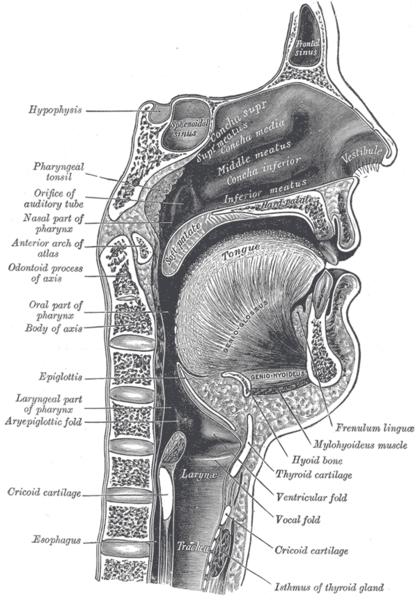
Although there is a body part called the “voice box” (also known as larynx), singing and talking require much more than just using that unique organ. Singers create sound using the abdominal and dorsal muscles, the rib cage, the lungs, the oral cavity and more.
The vocal cords (medically, these are “vocal cords“) are membranes that open and close by singing, talking or making noises. As the air pressure builds up against them, the folds snap together and a sound is created. When they are broken gently, a soft sound is heard; when they slam loudly, a loud noise is a result. The faster the cords open and close, the higher the resulting height will be. (These are long lasting suckers: the vocal cords open and close 100 times per second during normal speech.)
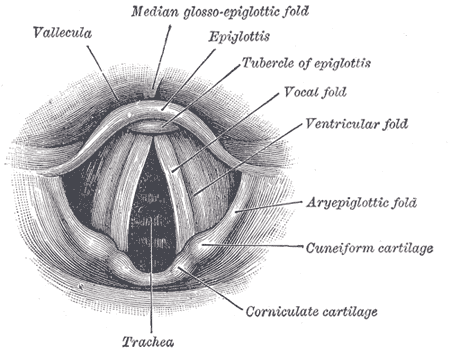
The vocal cords open and close
“False” vocal cords should not be confused with the wrinkles described above. The false vocal folds are simply over the genuine vocal cords and forestall nourishment, and so forth, from entering the trachea while gulping. They don’t generally assume a noteworthy part in speech or singing.
When you start singing, you start to breathe. The muscles of the larynx bring the vocal cords closer together. They remain closed until the breathing is sufficient (that is, the pressure is sufficient) and a puff of air escapes through the ropes. When you are out of breath, the vocal cords are brought closer together. (So now you know that the vocal cords do not work like a stringed instrument, they do not produce sound by vibrating against each other. The sound is produced by the pressure changes created when small air streams cross mobile vocal cords, why it may be useful to consider the control of breathing as the steam engine that operates the singing machinery.)
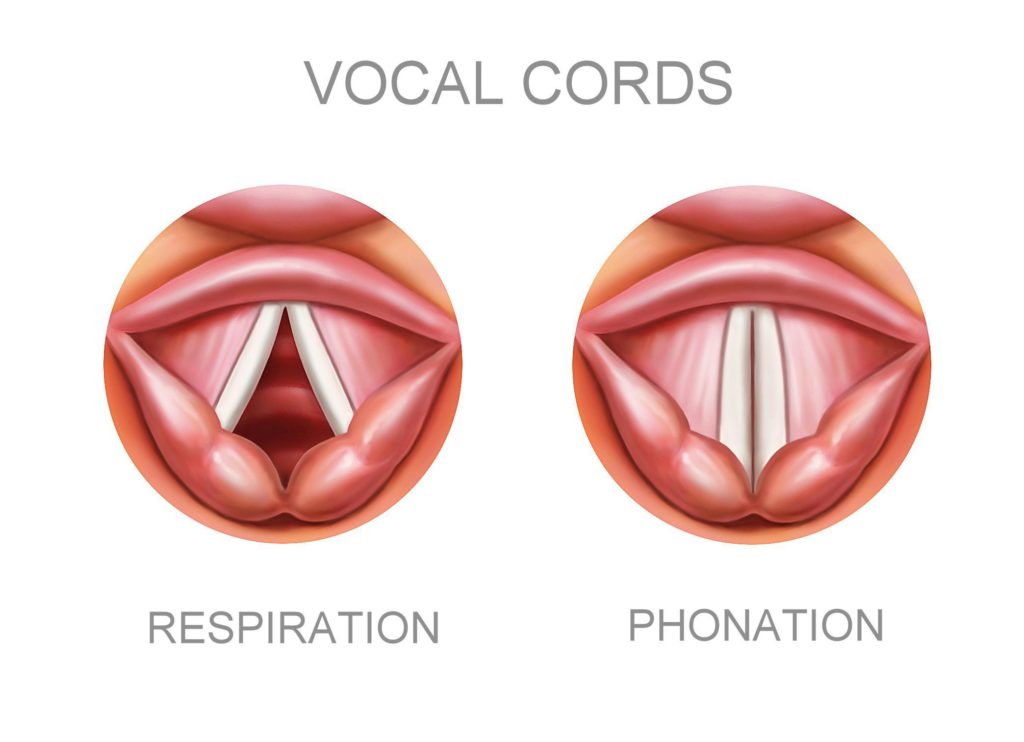
The image above is a microscopic illustration of the vocal cords. You can see that the very term “cord” is misleading because the strings are actually folds of fabric. These cords, or folds, consist of several layers, and in a healthy rope, the upper layer is loose.
The top illustration on this page will give you an idea of how the vocal cords open and close during sound recording. They do not open all at once; the lower part opens first, then gradually the ropes open widely then close again. Anything that interferes with this process (such as swelling caused by improper singing, smoking, etc., or small lesions that cause hoarseness) reduces the quality of the voice.
The vocal box (or larynx) rests in the neck and is composed of four basic elements: the skeleton, the “intrinsic muscles” (which move the vocal cords, among others), the “extrinsic muscles” (which adjust the position of the larynx) in the neck), and the mucosa. Intrinsic muscles change the position, shape, and strain of the vocal lines and can bring them closer, spread, or extend and stretch in length.
The tongue, the palate, the oral cavity, the nasal cavity, the sinus cavity, the thoracic cavity, the pharynx and other anatomical structures act as resonators for the singers; they are primarily responsible for voice quality. The vocal cords themselves deliver just a “buzzing” sound; resonators are expected to make music and speech. When we begin talking “arrangement” of the voice, we will for the most part manage the resonators, and discover how to utilize them the best.
A common way to find a “good” placement is to sing while smiling inside. This raises your cheekbones and allows the vocal sound to enter and resonate inside the area called “mask” (you will feel vibrations in the teeth/lips, cheekbone, nasal cavity and perhaps the forehead.
- Your sinus cavities is the point where you will resonate your highest notes.
- Your nasal cavity, your teeth/lips, and the upper pharynx (the so-called “mask”) is where your head’s voice is. This area is also important for high belts.
- The oral cavity, soft palate, and middle pharynx are the places where you will hear your chest voice. If you bring your lead voice into your lowest notes, he will also be “sitting” here.
- The upper chest cavity (which will make the chest bone vibrate) and the lower pharynx are the places where the voice of your chest sounds most often.
The power tool
What we usually call the diaphragm, or our “support system,” is the source of energy for singing. In fact, the anatomy of the “support system” is quite complicated and is not even fully understood by medical experts. The purpose of the support system is to “generate a force that directs a controlled airflow between the vocal cords that is necessary for vocalization.” The main muscles that help us breathe are the diaphragm (a dome-shaped muscle which extends along the bottom of the rib cage), and the “muscles of the ribs”.
Many muscles used to exhale are also in the “support system”. These muscles increase the abdominal pressure, forcing the diaphragm upwards, or lowering the ribs and chest bone, thus compressing the air in the chest. The muscles of the chest and back are also involved.
GREAT BOOKS WE RECOMMEND, CLICK ON THE IMAGE TO KNOW MORE! 🙂

